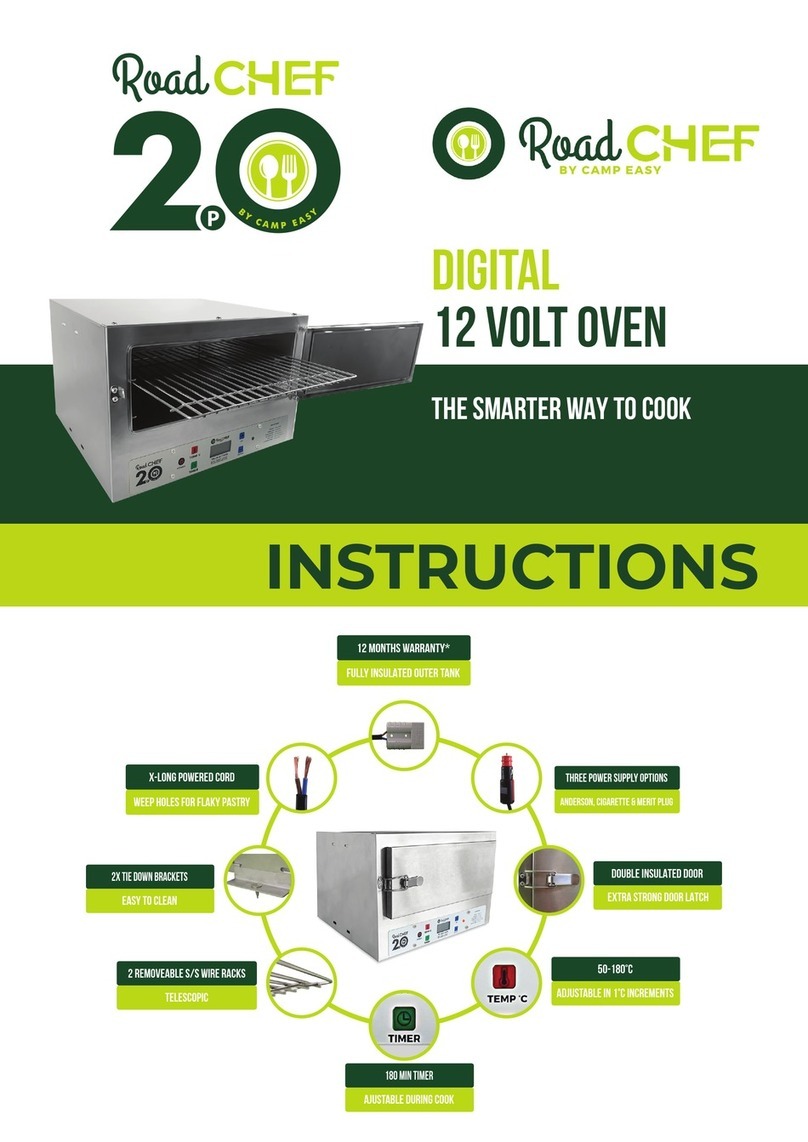
6
provide cooking time for a fan forced oven. As the BIG BERTHA is not fan forced it will take longer to
create similar results. To achieve the best results, we suggest you preheat the oven for 20 minutes on
BOTH and, 30 minutes on a single element, especially if you are cooking with fresh ingredients. To give
you a rough idea it will take you about 20/30 minutes preheating for the oven to get to 150 degrees for
both/single elements. The BIG BERTHA oven’s heat source is from elements directly against the top
and bottom of the inside of the oven. The heat is transferred around the oven through conduction of
the metal and convection in the air. During cooking at high temperatures, it is natural for the top and/
or bottom of the oven to ‘bow’ up.
Your oven’s heating element requires a high amount of heat, so the metal naturally expands. As the
four corners of the top/base are turned at 90 degrees the expansion is restricted focusing the expan-
sion, with the height of the racks on the bottom designed to consider the bowing. Like all ovens there
are hot and cool spots, so we recommend moving the items being cooked around during the cook for
optimal results.
Tips include: Place a silicone baking mat (approximately 230 x 170mm) in the centre of the oven base. Or
place the top rack on top of the bottom rack to help the heat circulate around the oven more evenly. We
recommend that you do not over fill the oven, which reduces air flow and to rotate your food between
shelves and on the shelves throughout the cook to avoid hot spots. Food in the baking tray or similar
coverings can be placed directly onto the bottom of the oven however you should check it regularly as it
is easy to burn food using this method. If you are reheating or cooking frozen food, we suggest that you
rotate your food between shelves and on the shelves throughout the cook to avoid the outside burning
before the middle is defrosted.
What you put into the oven
What you put in the BIG BERTHA significantly affects the amount of time it takes to cook it as does the
temperature selected and the elements selected to cook with. The time required to cook a roast is not
always the same! Even in your home oven it will take 1.5 hrs to do a 1kg pork roast, but it will take 3.5 hrs
to do a 3 kg roast. So, if you put 2 frozen pies into the BIG BERTHA it will take longer than 2 defrosted
pies. Similarly, if you bake in your BBQ heating with 4 elements burning will cook quicker than only 2.
A few good rules of thumb are to try not to ‘overload’ the oven, if you are ‘loading it up’ then always try
to defrost the items before putting them into the oven and rotate them between the top and bottom
shelves and the front and back throughout the cook.
Oven temperature
While BIG BERTHA is an oven, it is a 12-volt oven, not a 240-volt oven like you have in your house. While
it is very efficient at turning 12 volts of energy into heat so that you can bake, roast, and reheat, on the
road, it is not a 240-volt oven, so it is important not to expect the same performance. It will take about
20/30 minutes to preheat your oven to 150 degrees C. After the first 20/30 minutes the incremental
increase in temperature reduces to about 10 degrees per 10 minutes with the maximum temperature
achieved after about 50— 60 minutes. The more food you put in your oven, and the lower the tempera-
ture (if its frozen or room temperature) the longer the cooking time will be.
How you measure temperature
There are lots of different methods people will use to measure the temperature of an oven. What you
are looking to measure is the air temperature, not the surface temperature inside the oven. The oven
does have a thermostat that will turn the oven on and off when it reaches/falls below temperatures. This
cannot be accurately used as a temperature gauge by watching where the light turns off. If you want to
check the temperature, we recommend using one of the small gauges that can be purchased at most
kitchen shops. Get the smallest one and place it on the bottom rack of the oven. If you want to take it to
the next level, there are numerous digital and Bluetooth temperatures gauges on the market. The trick
with these is to make the opening for the wire as small as possible (bottom of the latch side of the door)
and that the probe does not sitting on the base of the oven as it needs to be measuring air temperature.



























